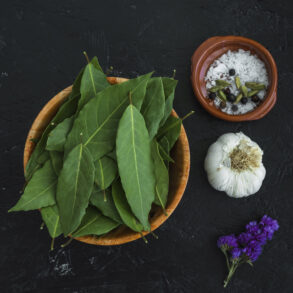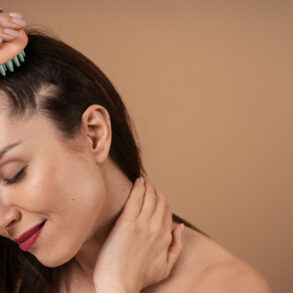Modern life causes stress, pollution, and excess chemicals —all of which affect our hair. Frizz, dullness, and too much shedding have become everyday struggles. Yet, many years before we started using commercial shampoos, Ayurveda was used for cleansing and nourishing hair through plants, fruits, and herbs.
Today, many people are rediscovering the timeless beauty secret of nature: making a homemade Ayurvedic shampoo for frizz and hair fall.
This guide blends traditional Ayurvedic knowledge with modern understanding to help you prepare natural cleansers that will help heal your hair.
1. Using Ayurveda for Your Hair Care
In Ayurveda, hair (Kesha) is more than a strand of protein. It’s a reflection of internal health and Ojas (vital energy). Healthy hair grows from a balanced body, calm mind, and clean scalp.
Unlike synthetic shampoos that rely on detergents, Ayurveda uses Moola-Prakriti (nature’s root intelligence) to gently remove dirt while preserving the scalp’s natural oils. The goal isn’t just “clean hair” but also nourished roots and strong follicles.
Thus, a homemade Ayurvedic shampoo for frizz and hair fall isn’t a beauty hack—it’s a daily act of self-healing. It balances Vata (dryness), Pitta (heat), and Kapha (oiliness).
2. The Root Causes of Frizz and Hair Fall
Before treating your hair, it’s essential to understand what causes frizz and shedding from an Ayurvedic perspective.
| Problem | Ayurvedic Cause | Modern Explanation |
|---|---|---|
| Frizz | Vata imbalance → dryness, roughness | Loss of natural oils, damaged cuticle |
| Hair Fall | Pitta aggravation → heat, inflammation | Hormonal stress, weakened roots |
| Dandruff + Weak Follicles | Kapha blockage in scalp channels | Fungal buildup, poor circulation |
A homemade Ayurvedic shampoo for frizz and hair fall targets these imbalances by using herbs that:
✅ Replenish moisture (for Vata),
✅ Cool the scalp (for Pitta), and
✅ Cleanse without stripping oils (for Kapha).
3. Key Ayurvedic Cleansing Herbs and Their Benefits
Ayurveda’s traditional hair cleansers are mild, nourishing, and medicinal. Below are the most potent ingredients used in any authentic homemade Ayurvedic shampoo for frizz and hair fall.
a. Reetha (Soapnut) – The Natural Cleanser
- Sanskrit Name: Arishtak
- Dosha Action: Balances Kapha and Vata
- Benefit: Contains natural saponins that lather mildly, removing dirt and excess oil.
- Bonus: Strengthens hair roots and adds volume.
b. Shikakai – The Hair Fruit
- Meaning: Literally “fruit for the hair.”
- Benefit: Natural detangler that smoothens frizz and maintains pH balance.
- Nutrients: Vitamin C and antioxidants that encourage growth.
c. Amla (Indian Gooseberry) – The Collagen Booster
- Ayurvedic Role: A Rasayana that rejuvenates follicles.
- Function: Stimulates new growth and reduces breakage caused by dryness.
- Why It Works: Rich in vitamin C, amla boosts collagen production in the scalp.
d. Hibiscus (Japa) – The Conditioner Herb
- Use: Petals and leaves contain mucilage that softens hair.
- Effect: Reduces tangles, seals moisture, and gives a glossy finish.
e. Fenugreek (Methi) – The Strengthener
- Ayurvedic Role: Nourishes Asthi Dhatu (bone tissue) linked to hair.
- Effect: Reduces shedding, fights dandruff, and improves elasticity.
Each herb works synergistically to make an effective homemade Ayurvedic shampoo for frizz and hair fall—a cleanser that both purifies and nourishes.
4. How to Make Natural Shampoos Based on Ayurveda
According to classical Ayurveda, a perfect herbal cleanser should fulfill three conditions:
- Keshya (Hair-strengthening) – Supports follicle vitality.
- Varnya (Complexion-enhancing) – Adds natural shine.
- Ropana (Healing) – Repairs scalp damage and dryness.
Therefore, when preparing a homemade Ayurvedic shampoo for frizz and hair fall, choose herbs that combine these three virtues. The aim isn’t foam it’s function.
5. DIY Recipes: Homemade Ayurvedic Shampoo for Frizz and Hair Fall
Here are some effective products you can make easily at home. These recipes combine Ayurveda’s ancient principles with practical, modern routines.
Recipe 1: Classic Reetha-Shikakai-Amla Cleanser
Ingredients:
- 10 Reetha pods
- 10 Shikakai pods
- 5 Amla pieces
- 3 cups water
Instructions:
- Soak all ingredients overnight.
- Boil in the same water for 15–20 minutes.
- Once cool, mash and strain the liquid.
- Store in a glass bottle in the fridge for up to a week.
Usage: Massage into wet hair, leave for 5 minutes, and rinse with cool water.
Results: Natural lather cleanses the scalp, strengthens roots, and controls frizz within 2–3 washes.
Recipe 2: Hibiscus and Aloe Moisture Shampoo
Ingredients:
- 10 hibiscus flowers or 15 leaves
- 2 tbsp aloe vera gel
- 1 cup water
- Optional: ½ tsp coconut milk
Preparation:
Blend all ingredients and strain. Apply directly to scalp and hair.
Results: Smoothens rough strands, hydrates dry hair, and reduces frizz naturally.
Ideal for Vata-dominant (dry) hair types.
Recipe 3: Fenugreek & Amla Protein Shampoo
Ingredients:
- 2 tbsp fenugreek seeds
- 1 tbsp amla powder
- 1 cup warm water
Method:
Soak fenugreek seeds overnight, grind into a paste, and mix with amla.
Benefits:
Strengthens weak roots, reduces shedding, and promotes healthy growth—making this one of the best homemade Ayurvedic shampoos for frizz and hair fall.
Recipe 4: Coconut Milk and Shikakai Cleanser
Ingredients:
- 1 cup coconut milk
- 2 tbsp shikakai powder
- 1 tsp aloe gel
Effect: Adds instant softness and gloss to extremely frizzy or curly hair. Coconut milk replaces lost oils, while shikakai maintains cleanliness.
6. Some Products of Ayurveda to Help Boost Efficacy
Enhance your homemade Ayurvedic shampoo for frizz and hair fall with these natural boosters:
| Ingredient | Function | Best For |
|---|---|---|
| Rose Water | Cooling, adds fragrance | Pitta scalp (sensitive) |
| Brahmi Extract | Calms stress, improves circulation | Hair fall from tension |
| Neem Powder | Antimicrobial | Dandruff, itchy scalp |
| Lemon Juice (few drops) | Balances pH | Oily scalp |
| Essential Oils (Lavender, Rosemary) | Promote relaxation, hair growth | All doshas |
Ayurvedic products like balance. Each addition should blend with rather than overpower the base herbs.
7. The Ayurvedic Washing Technique
How you apply your shampoo matters as much as the ingredients themselves.
Step-by-Step Method
- Pre-Oil Massage: Apply warm coconut or sesame oil 30 minutes before washing.
- Application: Use lukewarm water to wet hair. Apply shampoo from roots to ends, massaging gently.
- Wait: Leave for 3–5 minutes to let herbs absorb into follicles.
- Rinse: Use cool water to close cuticles.
- Condition: Apply hibiscus paste or aloe gel as a natural conditioner.
This routine ensures your homemade Ayurvedic shampoo for frizz and hair fall cleans effectively without leaving the scalp dry or stripped.
8. The Science Behind Ayurvedic Cleansers
While Ayurveda relies on wisdom from years of experience, modern studies now validate its herbal make-up.
- Reetha: Contains saponins that reduce dandruff-causing fungi (Malassezia).
- Shikakai: Exhibits antioxidant properties that prevent oxidative damage to hair keratin.
- Amla: Rich in ascorbic acid, boosts collagen around hair follicles.
- Fenugreek: Increases hair density and follicular strength in animal studies (Phytotherapy Research, 2006).
- Hibiscus: Shown in 2012 studies to promote faster hair regrowth and inhibit shedding.
Together, these herbs demonstrate that homemade Ayurvedic shampoos for frizz and hair fall are useful both traditionally and scientifically to caring for the hair.
9. Ingredients based on the Dosha: Which Shampoo Is Right for You?
Each dosha demands specific ingredients and textures to maintain harmony.
| Dosha Type | Hair Traits | Ideal Shampoo Herbs | Key Oils |
|---|---|---|---|
| Vata | Dry, frizzy, dull | Hibiscus, Aloe, Coconut milk | Almond or Sesame |
| Pitta | Sensitive, prone to thinning | Amla, Brahmi, Rose, Neem | Coconut or Bhringraj |
| Kapha | Greasy, heavy, dandruff | Reetha, Lemon, Triphala | Mustard or Tea Tree |
This table helps you design a personalized homemade Ayurvedic shampoo for frizz and hair fall based on your dosha dominance, which is true to Ayurveda’s individualized approach.
10. How Seasonal Adjustments Enhance Ayurvedic Hair Cleansing
In Ayurveda, Ritucharya—the practice of adapting to seasons—is vital for maintaining healthy hair. Each season shifts doshas and influences hair texture, oil balance, and strength. Adjusting your homemade Ayurvedic shampoo for frizz and hair fall seasonally prevents imbalances before they start.
| Season | Dominant Dosha | Common Hair Issues | Shampoo Adjustments |
|---|---|---|---|
| Winter (Hemanta) | Vata | Dryness, frizz, split ends | Add almond oil or coconut milk to herbal blend |
| Summer (Grishma) | Pitta | Heat, hair fall, inflammation | Include cooling herbs like hibiscus, rose, or aloe vera |
| Monsoon (Varsha) | Kapha | Dandruff, heaviness | Use reetha, triphala, or neem for detoxifying scalp |
| Autumn (Sharad) | Pitta | Thinning, irritation | Amla and sandalwood water as rinse |
| Spring (Vasanta) | Kapha-Vata | Dullness, buildup | Add lemon juice or mint for mild cleansing |
By respecting the seasons, your homemade Ayurvedic shampoo for frizz and hair fall aligns with your body’s natural cycles. This is an essential principle in Ayurvedic self-care.
11. Advanced Herbal Shampoo Recipes for Specific Hair Problems
Here are targeted formulas for different types of frizz and hair fall issues.
a. For Extremely Dry and Frizzy Hair
Ingredients:
- 5 hibiscus flowers
- 1 tbsp aloe vera gel
- 2 tbsp coconut milk
- 5 shikakai pods
Method:
Boil shikakai in a cup of water for 10 minutes, cool, strain, and mix with hibiscus paste, aloe, and coconut milk.
Effect: Deep moisture repair, glossy texture, and soft curls.
b. For Excessive Hair Fall
Ingredients:
- 2 tbsp fenugreek seeds (soaked overnight)
- 1 tbsp amla powder
- 1 cup reetha water
Method:
Grind fenugreek, mix with amla and reetha decoction.
Effect: Strengthens roots, reduces hair fall, and supports new growth.
c. For Dandruff and Itchy Scalp
Ingredients:
- 10 neem leaves
- 5 reetha pods
- 1 tbsp lemon juice
Method:
Boil neem and reetha together, strain, and add lemon juice.
Effect: Purifies scalp, kills dandruff-causing microbes, and maintains oil balance.
These versatile formulas prove how effective and customizable homemade Ayurvedic shampoos for frizz and hair fall can be across various hair challenges.
12. Ayurvedic Post-Wash Rituals
Washing hair in Ayurveda isn’t the end of the ritual, it’s only a part of the process. The next steps enhance shine, prevent frizz, and lock in nourishment.
a. Herbal Rinses
After shampooing, use one of these gentle rinses:
- Amla-Tulsi Tea Rinse: Restores shine.
- Rice Water & Aloe Rinse: Smooths cuticles.
- Rose Petal Rinse: Adds fragrance and cools scalp.
b. Post-Wash Oils
Light oils like almond, jojoba, or bhringraj can be applied sparingly on damp hair to preserve moisture.
c. Natural Leave-Ins
Aloe vera or hibiscus gel acts as a chemical-free leave-in conditioner.
These steps complement your homemade Ayurvedic shampoo for frizz and hair fall, transforming it into a holistic regimen rather than a one-time treatment.
13. Common Mistakes to Avoid in Herbal Hair Care
While natural ingredients are gentle, incorrect use can reduce effectiveness or cause buildup.
| Mistake | Consequence | Ayurvedic Correction |
|---|---|---|
| Overusing reetha or shikakai | Excess dryness | Add moisturizing herbs like hibiscus or aloe |
| Using hot water | Weakens follicles | Always rinse with lukewarm or cool water |
| Skipping oiling | Vata imbalance, frizz | Pre-oil before each wash |
| Using metal containers | Reacts with herbs | Store in glass or clay |
| Infrequent use | Delayed results | Consistency = visible transformation |
Mindfulness in preparation and application is important for your homemade Ayurvedic shampoo for frizz and hair fall to be gentle and powerful.
14. Ayurvedic Diet Tips for Healthy Hair
External care only works when internal nutrition supports it. Ayurveda links hair health to the nourishment of Asthi (bone tissue) and Rasa (plasma).
Include in Diet
- Protein: Moong dal, paneer, lentils.
- Iron: Spinach, jaggery, dates.
- Omega Fats: Ghee, flaxseed, walnuts.
- Herbal Tonics: Amla juice, fenugreek water, or Brahmi tea.
Avoid
- Fried and processed foods.
- Caffeine and excess salt.
- Sleeping late after oiling (it disturbs Agni, the digestive fire).
Following these dietary principles boosts the long-term results of your homemade Ayurvedic shampoo for frizz and hair fall.
15. How Modern Science Supports Ayurvedic Hair Care
Scientific studies increasingly confirm the powerfulness of Ayurvedic ingredients:
- Amla: Stimulates fibroblast growth and collagen formation (Journal of Ethnopharmacology, 2018).
- Fenugreek: Reduces hair shedding via phytoestrogenic activity (Phytotherapy Research, 2006).
- Hibiscus: Enhances hair follicle size and density (Journal of Chemical and Pharmaceutical Research, 2012).
- Neem: Acts as a broad-spectrum antifungal and antibacterial (Pharmacognosy Reviews, 2016).
This agreement of science and Ayurveda underscores the reliability of homemade Ayurvedic shampoos for frizz and hair fall—rooted in tradition, proven by research.
16. Real-Life Testimonials
- Anjali, 31: “Switching to hibiscus-aloe shampoo made at home completely transformed my curly hair—no frizz even in humidity.”
- Raj, 38: “Using reetha-amla decoction twice weekly stopped my hair fall in a month.”
- Meena, 45: “After decades of dandruff issues, neem and lemon shampoo finally gave me relief without burning my scalp.”
Such experiences echo a growing global realization: nature truly provides everything our hair needs.
17. Frequently Asked Questions
1. How often can I use homemade Ayurvedic shampoo?
Two to three times a week is ideal; daily washing isn’t necessary unless you have an oily scalp.
2. How long do these shampoos last?
Freshly made versions last 5–7 days when refrigerated. Avoid long storage without natural preservatives.
3. Can I mix essential oils into my shampoo?
Yes, a few drops of rosemary or lavender essential oil enhance scent and strengthen roots.
4. Will my hair feel sticky or heavy?
The first few washes may feel different as your scalp adjusts from chemical to natural cleansing. With time, hair becomes soft and balanced.
5. Are these shampoos color-safe?
Yes. They’re free from sulfates and safe for chemically treated or colored hair.
6. What if my scalp is very dry?
Add 1 tsp of aloe vera gel or coconut milk to your mixture.
7. Can men use these recipes?
Absolutely! Ayurveda’s principles are universal.
18. The Ethical and Environmental Issues of Ayurveda use
Choosing a homemade Ayurvedic shampoo for frizz and hair fall is also a conscious environmental act:
- Zero Waste: Herbs and flowers are biodegradable.
- Cruelty-Free: No animal testing—Ayurveda honors Ahimsa (non-violence).
- Sustainable: Uses renewable plant ingredients.
- Plastic-Free: Store in glass jars or steel bottles.
In an age of industrial haircare, going Ayurvedic restores both planetary and personal balance.
19. Key Takeaways
- A homemade Ayurvedic shampoo for frizz and hair fall cleans gently, nourishes deeply, and restores balance.
- Core herbs like reetha, shikakai, amla, hibiscus, and fenugreek are effective for all doshas.
- Customization and consistency yield lasting results.
- Pairing external care with proper diet and rest maximizes benefits.
- Ayurveda offers timeless, chemical-free beauty rooted in harmony.
20. Conclusion: The Return to Nature’s Wisdom
In a world flooded with man-made products, Ayurveda reminds us that true beauty is born of simplicity. A handful of herbs, a pot of boiling water, and a mindful touch—these are the only “technologies” our ancestors needed for lustrous, strong hair.
A homemade Ayurvedic shampoo for frizz and hair fall isn’t merely a recipe; it’s a reconnection—to nature, to balance, and to your roots. When you massage these living ingredients into your scalp, you’re not just cleansing—you are conversing with centuries of wisdom.
Let your hair breathe, shine, and grow—guided by the healing vibes of Ayurveda.










